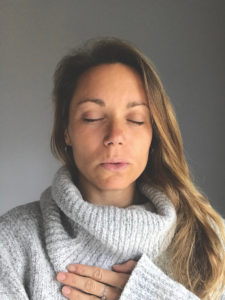Amid news reports of climbing infection rates, hospital bed shortages, and people ignoring guidelines during this unprecedented time, I can feel myself contracting. Lack of control has never been my jam. I know it’s true for many others, too: all this uncertainty and worry about things beyond our control is destabilizing.

Here’s something we do know for sure: there are small, concentrated steps we can take to limit our anxiety’s ability to run the show. Taking these steps will help us respond to real issues.
I learned one of these steps a little over a year ago, when psychologist Peter Levine held a free community meeting after the shark attack in Wellfleet took Arthur Medici’s life. Levine has developed a body-awareness approach to healing trauma.
After Arthur died, anxiety hummed like a bass line through my body, accentuated by panic attacks when I tried to get back in the water. What had been a safe and therapeutic place became my worst nightmare. My imagination was running wild. My breath would quicken, my vision would narrow, and I’d lose feeling in my face and fingers. I needed to do something. I called and texted friends to join me at the meeting. I knew people were hurting and anxious, just like me.
I followed a friend in and sat down. Front row. I felt okay. Levine started talking about animals and their adaptive responses. He spoke of antelopes running from predators. Hunters. Prey. We humans have similar neurological responses. But while animals can move from survival mode back to “normal” quickly, we tend to get stuck in the trauma response for periods of time.
Then Levine asked us to tell of our experiences. The room was quiet. I looked around, unsure of what I would say if I opened my mouth. I listened as one couple describe their experience of the day. Both medical professionals, they had walked past just after the attack, mistaking the movement in the water for play. Their grief was striking. Several others told their stories. My vision narrowed again. I began to cry, then breathe quicker, unable to control myself.
Kai Potter, to my right, put a hand on my shoulder to steady me. Levine turned to me and asked if he could sit closer to me. I nodded, unable to speak. Now sobbing, I felt a panic attack coming. He looked me in the eye, asked if it was okay to hold my hand, and began to explain what was happening. I felt the whole room turn toward me. Shame and terror flooded my body. His request was simple. Breathe in deeply. Then say the word “voo” as long as possible. It barely came out of my mouth at first.
After a few more tries, with Levine voo-ing with me, I began to calm down. My chest stopped heaving. My breathing steadied. The crying stopped. Levine backed his chair up and addressed the room.
After the meeting, Levine’s colleague Christina Morrow offered her services as a trauma therapist, free of charge, to anyone feeling affected. I gladly took her up on it. We perfected my breath practice, discussed where I felt tension in my body, and slowly worked through my hijacked stress response. I’ve employed this practice countless times since then. Before public speaking. After a breakup. Now.
The Voo Breath is a practice for de-escalating anxiety. When you’re feeling off-kilter, it may not be possible to use your usual coping mechanisms. Things like going to the gym, or meeting with friends and going shopping are off the table. For this time in our lives, it is imperative that we develop simpler practices to help us cope.
When the anxiety runs high, practice this: inhale steadily, then sing the word “voooooo” as long as you can. Repeat until you feel calmer.



